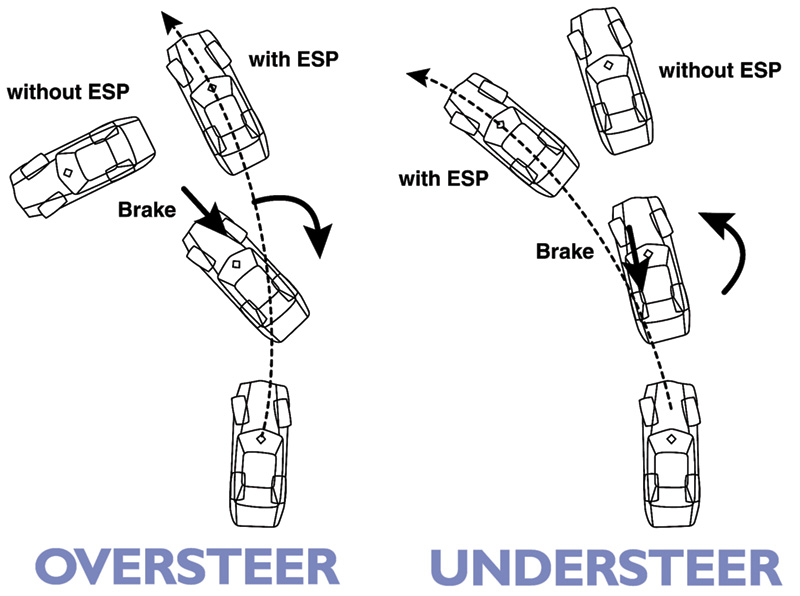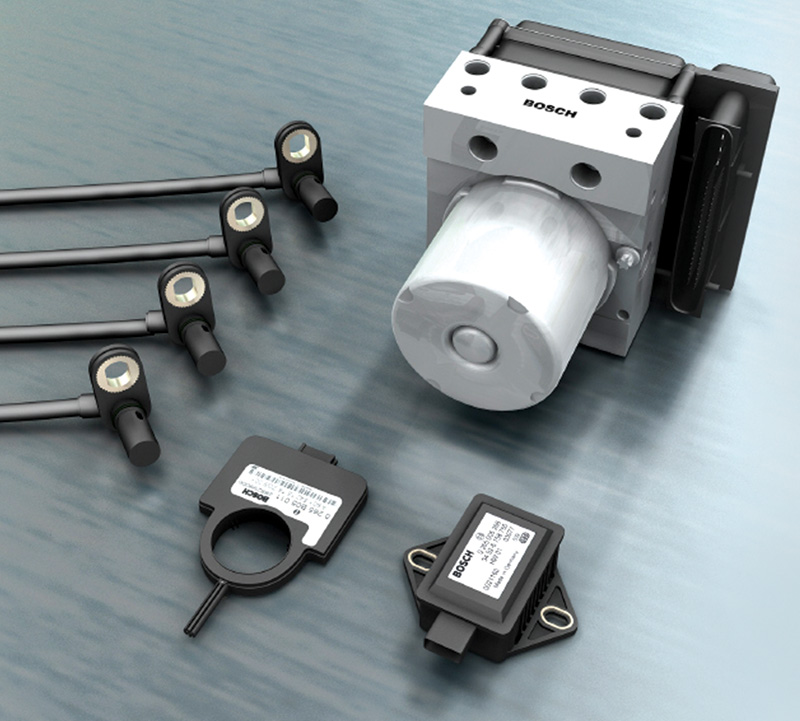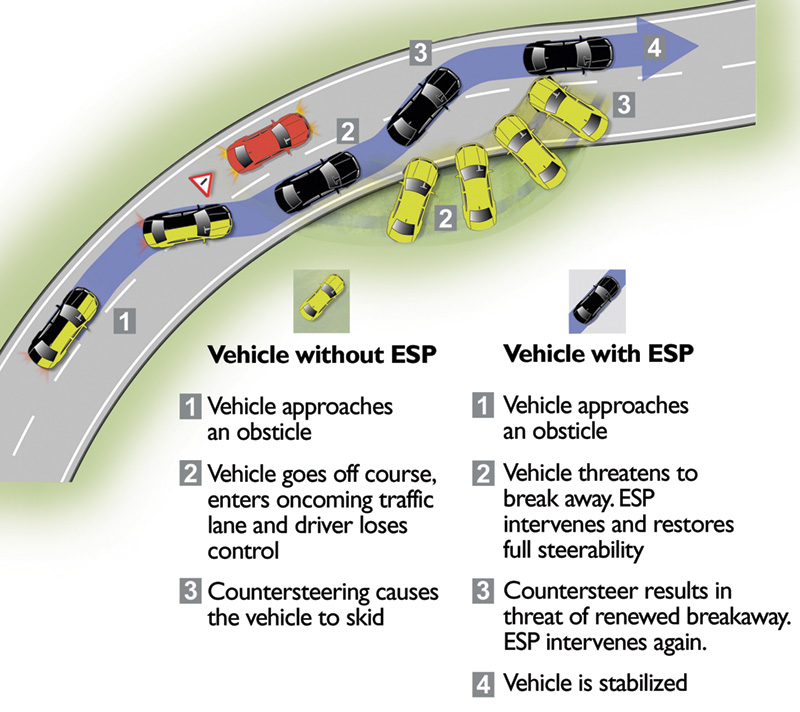Helping to keep drivers safe even when they make mistakes
No other recent automotive innovation has had such an immediate impact on accident-avoidance safety as the electronic stability system, such the Mercedes-Benz ESP (Electronic Stability Program). Multiple traffic safety studies, done by private groups and government agencies in the United States and Europe, credit stability control with reducing single-car crashes by up to 35 percent. For SUVs, the results are even more dramatic. The National Highway Traffic Safety Administration (NHTSA) says ESP cuts “single-vehicle†SUV crashes by 67 percent. Logically enough, according to the reports the reduction in accidents is accompanied by a corresponding reduction in fatalities and injuries.
In a statement issued when NHTSA released its findings, the agency said, “Electronic stability control appears to be highly effective in reducing single-vehicle run-off-road crashes such as rollovers and collisions with fixed objects… This technology appears to provide safety benefits by reducing the number of crashes due to driver error and loss of control, because it has the potential to anticipate situations leading up to some crashes before they occur, and has the capability in some cases to automatically intervene to prevent them.â€
According to NHTSA, if all vehicles on the road in the United States had an ESP system, up to 800,000 of the approximately 2 million single-vehicle crashes that now occur every year might be prevented.
The development of ESP was a multi-year “tandem†project done by Mercedes and Robert Bosch GmbH. “Tandem†is the term Mercedes uses to describe a complex project development effort between Mercedes and one of its key suppliers. According to Mercedes, because of its partnership approach with Bosch, “The usual time to develop such a system (ESP) was reduced by one-third, and development costs for the new system were lower than for the basic ASR traction control system.†Mercedes-Benz introduced ESP in the 1996 model year and it is now standard on all cars and SUVs.

When a vehicle “oversteers,†it turns too much, with the front end turning more than the driver intended (fishtails). When a vehicle “understeers,†it doesn’t turn enough. Instead of making the turn, the vehicle tends to slide toward the outside edge of the curve (plows).
Function
With the exception of drag racing and setting land speed records at the Bonneville Salt Flats, the ability to handle a car in the corners is critical to motorsports. Races are won and lost in the corners, and drivers are judged on how quickly and smoothly they can maneuver their car through a turn. When cornering, race drivers want to be on “the line†that allows them to make the turn smoothly and exit the turn, heading for the straight, at the highest possible speed.
If a driver misjudges his speed going into a corner, and can correct it in time, the only penalty is losing too much speed or taking too long to make the turn. If the driver cannot correct the mistake, the car will either “understeer,†going off the line and heading for the outside of the curve, or “oversteer,†with the rear of the car swinging around quickly and possibly going into an uncontrolled spin. In NASCAR terms, a car that has a tendency to understeer is “tight†and “pushes.†A car that wants to oversteer is “loose.â€
On the highway, the ability to safely control a car through a turn is no less important than on a race track. Most of the time on the road, speeds are slow enough, and road conditions are good enough, that safely controlling a car is not difficult. But whenever the combination of speed and road conditions creates a situation that approaches the limits of the vehicle’s ability to stay on the road, losing control because of understeer or oversteer is a serious risk.

This illustration shows the location of the ESP sensors and microcomputer in a new S-Class. The basic component placement is the same for all Mercedes-Benz cars and SUVs equipped with ESP.
Unfortunately, most motorists don’t know the signs or the “feel†of a vehicle approaching its handling limits. They don’t realize something is about to go wrong, until it happens and they have lost control. Then the typical response is to slam on the brakes and hope for the best.
Safely driving a car at or near its limits is a skill gained only with training, practice, and maybe a few crumpled fenders. Until ESP, that is. In a Mercedes-Benz car or SUV with ESP, the system senses an impending loss of control, either understeer or oversteer. It then corrects the problem by selectively applying the brakes. ESP can even apply brake force to only one wheel, something not even the most skilled driver can do.
Under dry road conditions, ESP is probably not particularly valuable to the rare, highly-trained driver who is skilled and experienced at driving a car near the limits of control. But ESP is very valuable in protecting the majority of drivers who find themselves in a situation where they are going too fast to make a turn. On wet or icy roads, even a skilled driver will benefit from having ESP because the system can regulate braking more effectively than even the best driver is able to do.

ESP shares some components, like the wheel speed sensors, with the ABS and ASR systems. But the yaw rate sensor and steering wheel angle sensor are strictly for ESP.
Extra Sensory Perception?
The development of ESP was the logical outgrowth of the marriage between chassis components and electronics that started when Mercedes introduced anti-lock braking (ABS) in 1978. ABS prevents individual wheels from locking under hard braking. After ABS, the next step was ASR (Acceleration Slip Regulation) traction control, which is the mirror of ABS. Instead of preventing wheels from locking up, which is what ABS does, traction control prevents excessive wheel spin when the tires on the drive wheels can’t get traction or “bite†on the pavement during acceleration.
ESP essentially combines ABS with additional sensors to monitor the driver’s steering wheel input and the directional movement of the car. ESP components include:
Wheel-Speed Sensors
Signals from the wheel speed sensors, already used for ABS and ASR, are key inputs to the ESP system. ESP continually monitors the relative speed of each wheel. Variations in wheel speed between outside and inside wheels are also used as a double check against the lateral acceleration sensor’s reading of the gravitational or sideways forces on the vehicle.
Hydraulic Modulator
ESP shares the same hydraulic modulator with ABS and ASR to regulate brake force. ESP, like ABS, can regulate braking at individual wheels to prevent loss of control. As Mercedes-Benz puts it, the system acts like it has four pedals, one for each wheel.
Steering Wheel Angle Sensor
This sensor monitors the driver’s steering wheel input to determine where the driver wants the car to go. The steering-wheel angle sensor has a working range of 720° with a tolerance of ± 5°.
Yaw Rate Sensor
The yaw rate sensor measures the rotation of the vehicle around its vertical axis. Picture a bird’s eye view of a car, looking straight down. The more the back end is shifted or rotated from a straight-ahead direction, the greater the yaw. If the centerline of the car is exactly on the direction the car is traveling, the yaw is zero. If the rear end has spun out, either to the left or right, so that the car is exactly sideways to the direction of travel, the yaw is 90 degrees. The rate of yaw change is measured continuously as the vehicle is traveling.
Micro-Computer
The ESP input signals are processed by the onboard computer, typically at the rate of about 25 times per second. Basically, the computer looks at the steering angle input—which is where the driver wants the car to go—and compares it with the input from the yaw rate sensor, which indicates the direction the car is going, as well as other sensors.
Calculations and actuations
The ESP works in the background — drivers almost never know it’s there. Even when the system corrects an out-of-control problem, the motorist is barely aware of what just happened.
Unlike ABS, which only works when braking, or ASR, which only comes into play during acceleration, ESP’s benefits are always available. Whenever the vehicle is moving, whether accelerating, traveling at a steady speed, or braking, ESP is monitoring the various inputs and taking corrective action as necessary to prevent loss of control. The system is effective on all road conditions, including rough, uneven surfaces; loose gravel; and snowy, icy, or wet roads.
ESP uses the angle of the steering wheel and the individual speeds of the four tires to calculate the path being steered or the direction the driver wants the car to go. At the same time, ESP, based on the gravitational forces and amount of yaw, measures what the car is actually doing.
Minor differences between the steering wheel angle input and yaw rate input do not trigger ESP action. But when the difference becomes significant, ESP goes to work. When the system detects an understeer condition, with the car trying to push toward the outside and not follow the turn, ESP applies brake hydraulic pressure to the inside rear wheel. If oversteer is detected, with the back end starting to swing around and put the vehicle into a spin, ESP increases brake pressure to the outside front wheel. For example, if the back end starts sliding to the right, ESP applies the right front brake to counter the oversteer and stabilize the vehicle (see page 15).
Just as ABS can “pump the brakes†for maximum braking faster than any human can, ESP braking control effectively provides faster counter steering to correct a skid than most drivers can.
ESP can’t raise “cornering speed†or the maximum speed that a car can travel going through a turn. Maximum cornering speed for any given corner, at any given time, is a complex function of the vehicle’s weight, engine power, suspension, brakes, tires, total chassis dynamics, and road conditions.
And, as the old saying goes, “Nothing is foolproof to a sufficiently talented fool.†If, for example, a driver tries to take a hard right turn at 90 miles an hour on a rain-slicked or icy road, ESP will do what it can to keep the car going where the driver wants to go, but the odds are very good that the driver will soon be testing other Mercedes-Benz safety features, including seat belts, airbags, and crumple zones.

With ESP, a potential crash is avoided because the system kept the vehicle under control as the driver goes through the turn too fast for conditions.
Zero complaints
No routine maintenance is required for ESP, and drivers don’t have to make any changes in their normal driving habits to benefit from the system. You should, however, advise customers to use only tires approved by Mercedes-Benz for their cars. And, as with ABS and ASR, ESP requires that all four tires be the original size and type. Differences in tire adhesion caused by using unmatched types or brands of tires reduce the effectiveness of ABS, ASR, and ESP.
Even vehicles with AWD and 4WD benefit from having ESP. AWD and 4WD give improved traction, especially when road conditions are poor, but they do not automatically correct loss of control situations when oversteer or understeer occurs. Only ESP can do that.
For all its complexity, ESP is very reliable. Because the system works in the background, and drivers often are not even aware of its presence, owner complaints about ESP performance are rare. Typically, the problems with ESP are sensor malfunctions that trigger a MIL (Malfunction Indicator Lamp). As with any code indication, follow the Mercedes-Benz diagnostic procedure for the specific vehicle year and model. Also, when the battery is disconnected, you might find that the ESP warning lamp is on, but the one for ABS is not. This is because the steering wheel angle sensor isn’t initialized. Simply turn the wheel lock to lock a few times with the key on. The only general troubleshooting advice we can offer is to check the wheel speed sensors for physical damage.






0 Comments